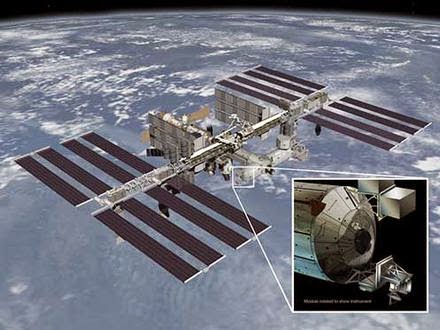Astronauts aboard the International Space Station (ISS) photographed this striking view of Pavlof Volcano on May 18, 2013.
The oblique perspective from the ISS reveals the three dimensional structure of the ash plume, which is often obscured by the top-down view of most remote sensing satellites.
The International Space Station has been called a stepping stone to other worlds.
NASA hasn't forgotten, however, that the behemoth space station is also on the doorstep of Earth.
"We're seeing the space station come into its own as an Earth-observing platform," says Julie Robinson, chief scientist for the International Space Station Program.
"It has a different orbit than other Earth-observing satellites. It's closer to Earth, and it sees Earth at different times of day with a different schedule."
In short, the space station offers something unique to the study of our home planet.
Sometimes astronauts in low Earth orbit to see what regular satellites do not. In May 2013 for example, astronauts on board the International Space Station photographed a fresh eruption of the Pavlof Volcano in the Aleutian Islands.
Their oblique perspective revealed the three dimensional structure of the ash plume, which was only 20,000 feet high, but many times longer. Down-looking satellites could not get the same kind of 3D information.
Low Earth orbit turns out to be a great place to study the planet below. In recent years astronauts trained to photograph Earth have gathered data on desert dust, coral reefs, urban growth, pollution, glaciers, hurricanes, lightning, river deltas, volcanic plumes, Northern and Southern Lights and much more.
Now, however, NASA is taking the space station's Earth-observing capabilities to a whole new level.
Before the end of the decade, six NASA Earth science instruments will be mounted to the station to help scientists study our changing planet.
The upgrades began this month: On Sept. 20th, a SpaceX resupply rocket blasted off from Cape Canaveral carrying the first NASA Earth-observing instrument to be mounted on the exterior of the space station: ISS-RapidScat will monitor ocean winds for climate research, weather predictions and hurricane science.
Next up is the Cloud-Aerosol Transport System (CATS) a laser radar that can measure clouds along with airborne particles such as pollution, mineral dust, and smoke. CATS will follow ISS-RapidScat on another SpaceX flight targeted for December.
Two more Earth science instruments are slated to launch in 2016.
First, SAGE III will measure ozone and other gases in the upper atmosphere to help scientists assess how the ozone layer is recovering.
Second, the Lightning Imaging Sensor will monitor thunderstorm activity around the globe.
Those instruments are already built and ready to fly. In July, NASA selected proposals for two new instruments: The Global Ecosystem Dynamics Investigation (GEDI), and the ECOsystem Spaceborne Thermal Radiometer Experiment on Space Station (ECOSTRESS), will give scientists new ways to observe how forests and ecosystems are affected by climate change. Both will be completed before the end of the decade.
The oblique perspective from the ISS reveals the three dimensional structure of the ash plume, which is often obscured by the top-down view of most remote sensing satellites.
The International Space Station has been called a stepping stone to other worlds.
NASA hasn't forgotten, however, that the behemoth space station is also on the doorstep of Earth.
"We're seeing the space station come into its own as an Earth-observing platform," says Julie Robinson, chief scientist for the International Space Station Program.
"It has a different orbit than other Earth-observing satellites. It's closer to Earth, and it sees Earth at different times of day with a different schedule."
In short, the space station offers something unique to the study of our home planet.
Sometimes astronauts in low Earth orbit to see what regular satellites do not. In May 2013 for example, astronauts on board the International Space Station photographed a fresh eruption of the Pavlof Volcano in the Aleutian Islands.
Their oblique perspective revealed the three dimensional structure of the ash plume, which was only 20,000 feet high, but many times longer. Down-looking satellites could not get the same kind of 3D information.
Low Earth orbit turns out to be a great place to study the planet below. In recent years astronauts trained to photograph Earth have gathered data on desert dust, coral reefs, urban growth, pollution, glaciers, hurricanes, lightning, river deltas, volcanic plumes, Northern and Southern Lights and much more.
Now, however, NASA is taking the space station's Earth-observing capabilities to a whole new level.
Before the end of the decade, six NASA Earth science instruments will be mounted to the station to help scientists study our changing planet.
The upgrades began this month: On Sept. 20th, a SpaceX resupply rocket blasted off from Cape Canaveral carrying the first NASA Earth-observing instrument to be mounted on the exterior of the space station: ISS-RapidScat will monitor ocean winds for climate research, weather predictions and hurricane science.
Next up is the Cloud-Aerosol Transport System (CATS) a laser radar that can measure clouds along with airborne particles such as pollution, mineral dust, and smoke. CATS will follow ISS-RapidScat on another SpaceX flight targeted for December.
Two more Earth science instruments are slated to launch in 2016.
First, SAGE III will measure ozone and other gases in the upper atmosphere to help scientists assess how the ozone layer is recovering.
Second, the Lightning Imaging Sensor will monitor thunderstorm activity around the globe.
Those instruments are already built and ready to fly. In July, NASA selected proposals for two new instruments: The Global Ecosystem Dynamics Investigation (GEDI), and the ECOsystem Spaceborne Thermal Radiometer Experiment on Space Station (ECOSTRESS), will give scientists new ways to observe how forests and ecosystems are affected by climate change. Both will be completed before the end of the decade.










No comments:
Post a Comment